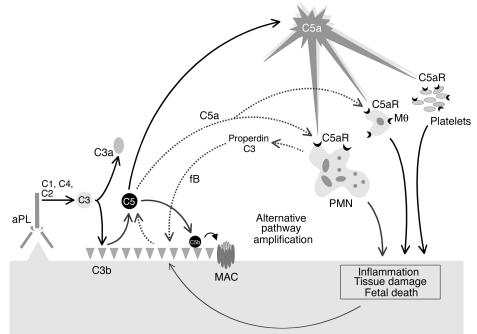Figure 8.
Mechanism of aPL Ab–induced fetal damage. APL Ab’s are preferentially targeted to the placenta where they activate complement via the classical pathway leading to the generation of potent anaphylatoxins and mediators of effector cell activation, particularly C5a. C5a attracts and activates neutrophils, monocytes, and platelets and stimulates the release of inflammatory mediators, including reactive oxidants, proteolytic enzymes, chemokines, cytokines, and complement factors C3 and properdin. Secretion of C3 and properdin by neutrophils, as well as the presence of apoptotic and necrotic decidual tissue, may accelerate alternative pathway activation (dashed line), creating a proinflammatory amplification loop at sites of leukocyte infiltration that enhances C3 activation and deposition and generates additional C5a. This results in further influx of neutrophils, inflammation within the placenta, and, ultimately, fetal injury. Depending on the extent of damage, either death in utero or fetal growth restriction ensues.PMN, neutrophil; Mθ, monocyte/macrophage.

